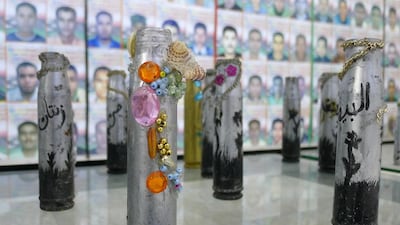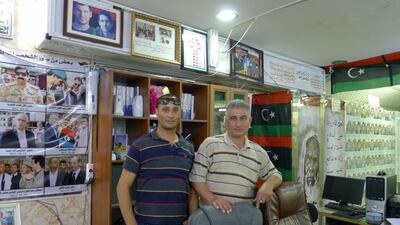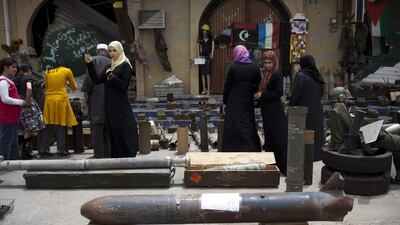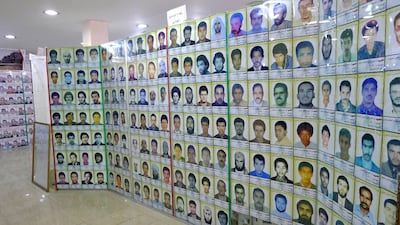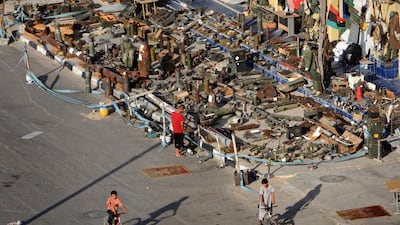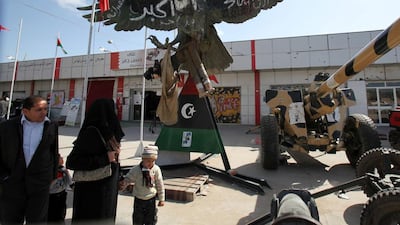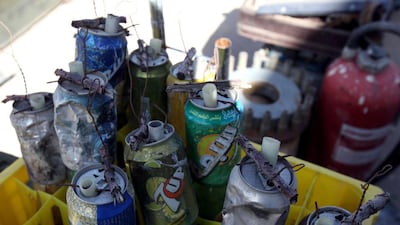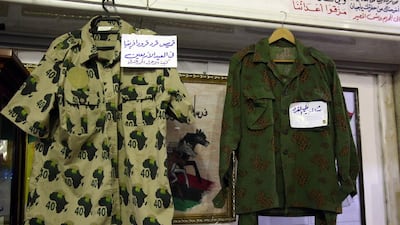Opposite war-scarred buildings riddled with bullet holes from months of fighting during Libya’s 2011 uprising, Qaddafi-era sculptures loom over tanks and heavy weapons crowding the pavement outside the Misurata War Museum.
Relocated to the city as part of the victorious spoils of war, the bullet-peppered paintwork of a giant fist crushing a United States fighter plane is now flaking off, with rust spreading across the metallic folds of the anti-American monument commissioned by Qaddafi in 1986, after US air strikes in Libya. A giant eagle sculpture seized from barracks run by one of the former dictator’s sons is mounted on the museum’s roof, beneath which, tens of tricolour Libyan flags flutter in the wind – symbolising a unity in the uprising that unfortunately proved short-lived.
Although the museum is in part a memorial to the victory against Qaddafi, inside it is a tragic testimony to the loss of Libyan lives. Stepping across a doormat featuring the former dictator’s face, visitors are greeted by walls lined with photographs of the faces of thousands of men, women and children who died, either during Qaddafi’s 42-year rule, during the uprising that overthrew him or in Libya’s chaos of civil conflicts that has followed.
There are more than 5,000 people listed in the museum as martyrs, and new names are added whenever another is brought to its attention, usually by a relative. “Even today we received a new name, of a soldier killed in an attack on a nearby checkpoint,” says Taher Bashir Sheneba, the museum’s head curator.
The process is straightforward, requiring a death certificate, evidence that the deceased should be classified as a martyr and a photograph.
The museum is run by volunteers and is exclusively funded by donations. Bashir says the museum has never received any government funding: “We do everything for free here because it is like humanitarian work.”
As well as being a visitor attraction, it provides a space where grieving family members can come and remember their dead. This is something that Bashir’s brother and fellow volunteer, Mohamed, says is an important role of the museum.
“We have about 50 families who have two or three martyrs here, and some mothers have lost three or four sons,” he says. “One mother comes here and stands in front of the images of her sons and cries for hours, and sometimes a young child whose father is listed here gets a little emotional when she sees a photo of her father.”
Originally envisaged as a memorial to Misuratan martyrs, Bashir says the museum expanded to become a project to include all martyrs in Libya. But this idea relates to a time of unity among Libyans, which quickly splintered. There are sections dedicated to the martyrs of 2011 from the towns of Bani Walid and Zintan, with which Misuratan troops have since had fierce conflicts.
Brigades from the city have led a series of offensives as the situation in Libya has deteriorated into a complex web of civil conflicts. The museum continues to receive details of those killed in the past two years, including more than 200 men killed in the 2014 battle for control of the capital, Tripoli, that left the international airport destroyed and created deep political divisions – something the country still struggles with. There is no place for those they recently fought against – former revolutionary comrades turned enemies.
“Before, the museum was for the whole of Libya, but now it has become very focused on Misurata,” says a visitor. “For me, it has now become a symbol of post-revolution disharmony.”
Although recently listed martyrs are mostly from Misurata, this is partly because families are responsible for bringing the deaths to the attention of the curators, and the work of the museum remains best-known locally.
Recent martyrs include nine men killed by ISIL militants, who have seized control of 200 miles of central Libyan coastline and against whom Misurata forces battled last year. The growing presence of ISIL and the violence that has followed has been recognised by the museum, which is now planning a section for the growing number of Libyans killed by the extremists, including those publicly executed in town squares.
An important feature of the museum is its collection of armaments. Shell casings from anti-aircraft guns decorated by children with paint and colourful beads are lined up on top of glass cases containing Qaddafi memorabilia; and a multiple-rocket launcher, its barrels painted in the Libyan flag colours of black, red and green, stands before images of those killed during Qaddafi’s rule, including the martyrs of Abu Salim, where more than 1,000 prisoners deemed a threat to the former regime were executed in 1996.
Outside the museum, the remnants of heavy weapons and ammunition stores are piled up beside tanks and military vehicles.
“The weapons are there so people can remember what happened here in 2011 and imagine how severe the war was in Misurata, especially here on Tripoli Street,” says Bashir. “We also want people to know what weapons are, how dangerous they can be and that they should not be touched.”
The danger of the display became apparent in 2013, when the international mine clearance organisation Mines Advisory Group visited the museum and found children playing among live munitions collected and donated by local people.
Bashir asked the group to secure risky objects, and 363 items, including six Soviet S-24 rockets, an SA-3 missile and a 400-kilogram bomb were deactivated or removed.
Since it was established in 2011, the museum has become one of Misurata’s main visitor attractions. The number of foreign visitors dropped dramatically after the exodus of international organisations and embassies during the 2014 battle for Tripoli, but the museum continues to attract many local and regional visitors.
“We hope that all foreign visitors to Misurata, as well as local people and Libyans, will visit us here,” says Bashir. “After all, this is the only museum of its kind.”
Tom Westcott is a freelance journalist based in Libya.
